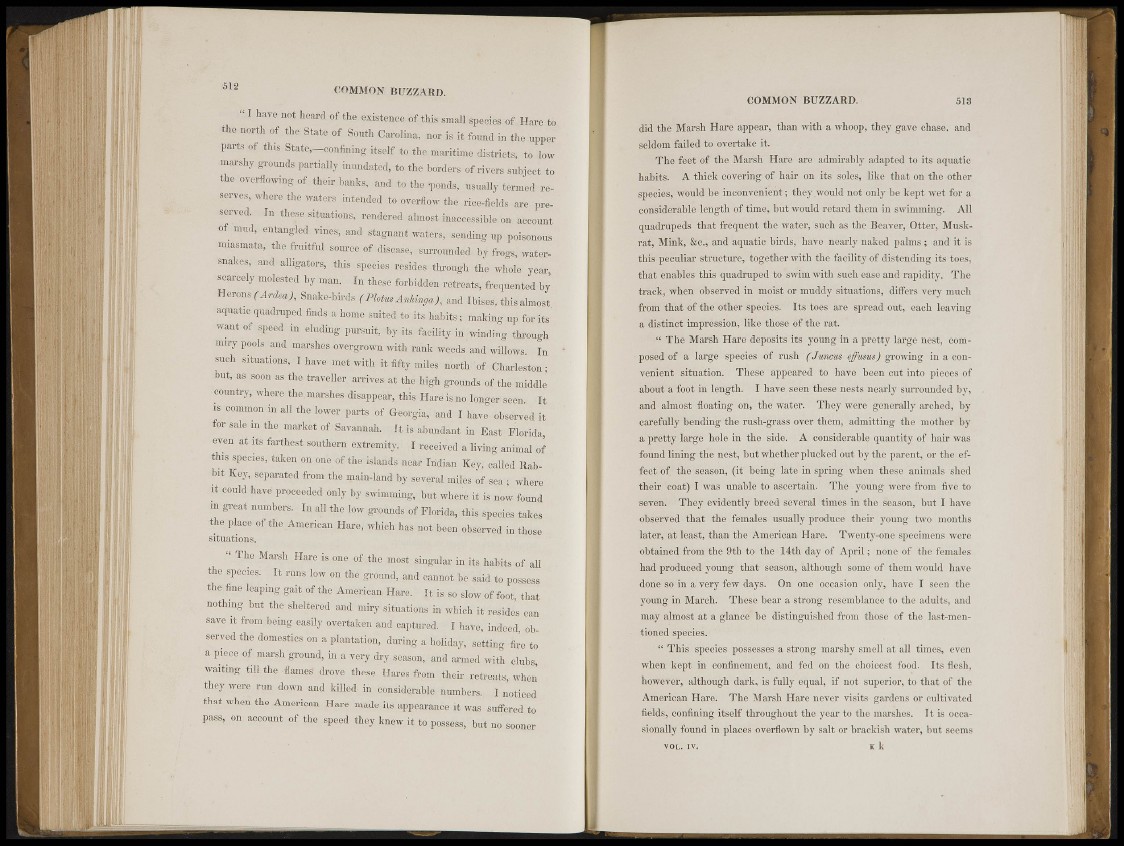
512 COMMON BUZZARD.
" I taf® notheaid of the. eristence.of this small species of Hare to
* * * of t h e S t a t e of Sonft Carolina, not is it found in the, upper
this State,.-eonfa&g itself to the marifame districts,. to low
marshy grounds partially « d a t e d , to the borders of rivers subject to
the overflowing of their banks, and to the -ponds, usually termed» re-
. serves, where the waters «tended to overflow the riee-fields are pre-
Sel'Ted- t] i e s e s i f c a t i o n s ' rendered almost «accessible on account '
mud, entangled vines, and stagnant waters, sending up poisonous
miasmata, the fruitful source of disease, surrounded by feogs, watersnakes,
and alligators; this species resides tJwwgk the whole year
scarcely molested by man In these forbidden retreits, frequented by'
Herons (Afdea), Snake-birds (PU^ A n h m g a ) , and Ibises, this almost
aquatic quadruped feds a. home suited to its. h a b i t sma k i n g up for its
want of speed in eluding pursuit, by'its facility iu Uncling through
miry pools and marshes overgrown with rank weeds and willows In
sueh situations, I have met with it fifty niileS north ^Cha r l e s ton •
but, as .soon as the traveler, arrives at the high grounds of the middle
- 'country, where the maah.es,,disappear, Wis Hareisno longer seen It
18 C ° m m 0 m » $ lwer of Georgia, and I have observed it
fosale 111 t h e m a r i e t of Savannah. It is abundant in East Morida
' even at .its farthest southern extremity.. I received a living animal of
this species, taken oh one Of the islands near Indian Key, called Babbit
Key, separated from the main-land by several miles of s s ^ where '
it could have proceeded only by swimming,, but where, it is now found '
m great numbers. Inalthe low g!-„u,,ds ,,f Horida, t h i s ^ f t S f c 9 s
the place..o£the Amemcan Hare^hiol i has not be® observed in those
situations.
« The Marsh Hare is one of .the most singular in its habits of all
the species. It runs low on the ground, and cannot be said,to possess
the fine leaping gait of the American Hare. It is so slow of foot that
nothing hut the sheltered and miry situations in which it resides can
save it from being easily overtaken and captured. I have, indeed observed
the domestics on a plantation, during a holiday, setting ¿ e to
a piece of marsh ground, in a very dry season, and armed with clubs
waiting till the-flames drove these Hares from their retreats, when'
they were run down -and killed- in considerable numbers. I noticed
that when the American Hare made its appearance it was suffered to
pass, on account of the speed they knew it. to possess, but no sooner
COMMON BUZZARD. 513
did the Marsh Hare appear, than with a whoop, they gave chase, and
seldom failed to overtake it.
The feet of the Marsh Hare are admirably adapted to its aquatic
habits. A thick covering of hair on lis soles, like that on the other
species, would be inconvenient ; they would not only be kept wet for a
considerable length of time, but would retard them in swimming. All
quadrupeds that frequent the water, such as the Beaver, Otter, Muskrat,
Mink, &c., and aquatic birds, have nearly naked palms ; and it is
this peculiar structure, together with the facility of distending its toes,
that enables this quadruped to swim with such ease and rapidity. The
track, when observed in moist or muddy situations, differs very much
from that of the other species. Its toes are spread out, each leaving
a distinct impression, like those of the rat.
" The Marsh Hare deposits its young in a pretty large nest, composed
of a large species of rush (Jwrbcus effusus) growing in a convenient
situation. These appeared to have been cut into pieces of
about a foot in length. I have seen these nests nearly surrounded by,
and almost floating on, the water. They were generally arched, by
carefully bending the rush-grass over them, admitting the mother by
a pretty large hole in the side. A considerable quantity of hair was
found lining the nest, but whether plucked out by the parent, or the effect
of the season, (it being late in spring when these animals shed
their coat) I was unable to ascertain. The young were from five to
seven. They evidently breed several times in the season, but I have
observed that the females usually produce their young two months
later, at least, than the American Hare. Twenty-one specimens were
obtained from the 9th to the 14th day of April ; none of the females
had produced young that season, although some of them would have
done so in a very few days^ On one occasion only, have I seen the
young in March. These bear a strong resemblance to the adults, and
may almost at a glance be distinguished from those of the last-mentioned
species.
" This species possesses a strong marshy smell at all times, even
when kept in confinement, and fed on the choicest food. Its flesh,
however, although dark, is fully equal, if not superior, to that of the
American Hare. The Marsh Hare never visits gardens or cultivated
fields, confining itself throughout the year to the marshes. It is occasionally
found in places overflown by salt or brackish water, but seems
VOL. IV. E k